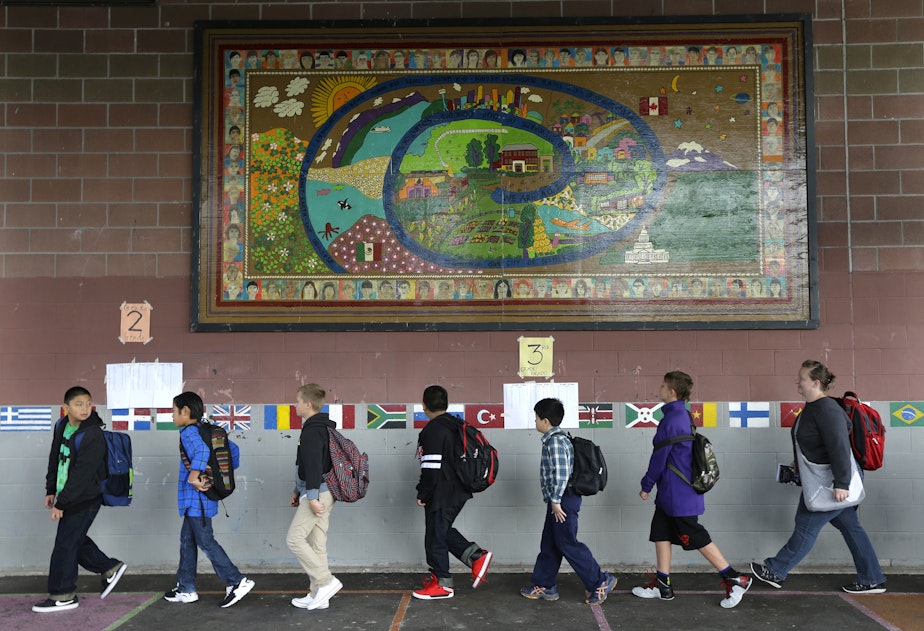Run. Hide. Fight? Experts say some active shooter drills go too far for younger kids

Some districts are training kids against armed assailants with "Run. Hide. Fight" simulations and videos. Experts say these techniques are unproven, and inappropriate for elementary school.
Under Washington state law, schools must practice lockdowns in case of an armed assailant. But how young is too young for the most intense training?
Marina Hiles works for the Auburn School District. She saw that when the youngest students practiced even traditional lockdown drills, the line between practice and reality could be blurry.
“In elementary one of the little ones asked if I could be his mom right now, because he was afraid of what was happening, even though it was just a drill,” she said. Hiles said it’s hard to comfort all 25 to 30 kids in a group during the drills, but she doesn’t hesitate. "I'm a mom, I had five kids and I’m always a mom even when I’m at school, so I always tell them, ‘Yes, I can be your mom right now.’”
Sergeant Craig White with the Snohomish County Sheriff’s Office says when he works with elementary schools in violent scenarios, he trains the teachers, not the kids.
“You can’t expect a six year old or a five year old to fight against an adult,” he said. “When it comes down to it, we trust that our teachers will shelter us. And we trust that hopefully law enforcement gets there in time to eliminate the issue.”
Sponsored
He’s well aware of the value of drills for adults. He saw that vividly in the shooting at Marysville-Pilchuck High School in 2014. “I was a sergeant in charge when we entered the school and cleared the cafeteria,” he said. That’s where a student shot five other freshmen, leaving four dead and one wounded. The teen then shot himself. White entered the school with officers he’d never seen, from different agencies, whose names he didn’t know.
"They followed my lead and were with me going from classroom to classroom. And you can attribute that to the training everyone has done nationwide on how to respond to a school shooting.”
But how to prepare kids for these extremely rare situations is more contentious. According to the National Association of School Psychologists, armed assailants in schools account for 1 percent of homicides among school-age youth. Some districts have embraced videos and simulations to teach kids to run, hide and even fight back against a school shooter. But that approach is controversial.
Mike Donlin heads the state’s School Safety Center. “One of the things we often remind people of is ‘run hide fight’ was not developed for schools. ‘Run hide fight’ was developed for workplace situations, office situations. And the ‘fight’ part of it is not necessarily that you’re going to teach your kids to fight,” he said.
Sponsored
Training should be tailored to the students’ ages and focus on traditional lockdowns, not simulations, according to a "best practices" guide developed by school psychologists and law enforcement. Donlin said the state – while requiring drills -- can’t tell districts how to do them. But he noted that getting parental consent before training is another “best practice.”
“Do we need to contact moms and dads ahead of time, if so how are we going to do that, what are we going to tell them?You know, all those kinds of things really would be the ideal processes to go through,” he said.
Officials with the Federal Way School District followed this approach when they developed a new video instructing students in “run, hide and fight” strategies this year.
“Parents were able to view all training materials in advance,” ask questions, and choose to have their children opt out of the training if necessary, said district spokesperson Kassie Swenson.

Sponsored
Shannon McCann is a special education teacher and president of the Federal Way Education Association, the local teacher's union. She said after parents and staff objected, the district eliminated discussion of “fighting back” for elementary students. “Teachers and parents spoke up, and the plan was modified to be more age-appropriate,” McCann said. She said the district is the most diverse in the state, and teachers are concerned about “re-traumatizing” any students who have been exposed to violence. McCann said educators want mental health experts to have input on any trainings. And she’s hopeful about proposed legislation that would supply more nurses and therapists in schools.
Carrie Suchy, a school psychologist in Franklin Pierce School District near Tacoma, said that improving student access to mental healthcare “is where we’re going to see a bigger longterm impact.” Suchy said she doesn’t observe kids having too much anxiety around lockdown drills. “Sometimes that’s actually a problem,” she said. “We work really hard at school when we do drills to get kids to take them seriously.”
But she said she has more concerns about active shooter simulation training.
“Those are definitely anxiety provoking,” she said. One of the best-known is ALICE training, which she said neighboring districts have used and her district considered using. “We decided against it, just looking at the cost and the benefit it didn’t make sense to put our students through that,” she said.
Sponsored
Suchy is part of a local crisis recovery team. They’ve helped principals deal with emergencies including a student being arrested at school, a student attempting suicide, and a staff member suffering a stroke at school. She said the biggest needs in schools are for suicide prevention and other ways to support students, not measures against armed intruders. “Kids not feeling safe at school and kids not feeling safe in their own skin is a huge problem,” Suchy said.




